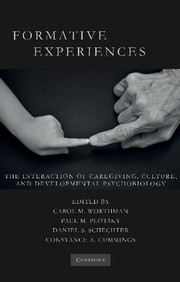Book contents
- Frontmatter
- Contents
- List of Figures
- List of Tables
- List of Contributors
- Foreword by Robert Sapolsky
- Preface
- List of Abbreviations
- Introduction
- SECTION ONE HISTORICAL, CROSS-CULTURAL, AND DEVELOPMENTAL SCIENCE PERSPECTIVES
- SECTION TWO HOW EXPERIENCE INTERACTS WITH BIOLOGICAL DEVELOPMENT
- SECTION THREE FORMATIVE RELATIONSHIPS WITHIN AND ACROSS GENERATIONS
- SECTION FOUR SOCIAL AND CULTURAL CONTEXTS OF CHILDHOOD DEVELOPMENT – NORMATIVE SETTINGS, PRACTICES, AND CONSEQUENCES
- SECTION FIVE FEAR, FUN, AND THE BOUNDARIES OF SOCIAL EXPERIENCE
- SECTION SIX PUBLIC HEALTH, EDUCATION, AND POLICY IMPLICATIONS
- Index
SECTION TWO - HOW EXPERIENCE INTERACTS WITH BIOLOGICAL DEVELOPMENT
Published online by Cambridge University Press: 26 May 2010
- Frontmatter
- Contents
- List of Figures
- List of Tables
- List of Contributors
- Foreword by Robert Sapolsky
- Preface
- List of Abbreviations
- Introduction
- SECTION ONE HISTORICAL, CROSS-CULTURAL, AND DEVELOPMENTAL SCIENCE PERSPECTIVES
- SECTION TWO HOW EXPERIENCE INTERACTS WITH BIOLOGICAL DEVELOPMENT
- SECTION THREE FORMATIVE RELATIONSHIPS WITHIN AND ACROSS GENERATIONS
- SECTION FOUR SOCIAL AND CULTURAL CONTEXTS OF CHILDHOOD DEVELOPMENT – NORMATIVE SETTINGS, PRACTICES, AND CONSEQUENCES
- SECTION FIVE FEAR, FUN, AND THE BOUNDARIES OF SOCIAL EXPERIENCE
- SECTION SIX PUBLIC HEALTH, EDUCATION, AND POLICY IMPLICATIONS
- Index
Summary
INTRODUCTION
A recent breakthrough in developmental biology is recognition that development is a dance between nature and nurture. Once the focus turned from debates pitting nature against nurture to understanding how the two necessarily work together, whole new avenues of research opened up. In consequence, many previously intractable puzzles have been answered or reframed. By now it is clear that, by organic design, development is environment-expectant. This revelation has stimulated an explosion of work on epigenesis and greatly sharpened attention to context. Epigenetics concerns development and operation of mechanisms that regulate genetic activity without changing the DNA sequence itself. As reviewed by Szyf and colleagues in this section, the epigenome comprises the configuration of structures enveloping the genome that control its activity. A growing body of evidence details how the configuration is dynamically shaped through a suite of mechanisms sensitive to environmental circumstances. Thus, different outcomes are produced largely by differences in how the genetic message is read, not in the message itself. This work electrifies scientists who long have struggled to reconcile the manifest role of genetics with the equally manifest impact of circumstance while avoiding bioreductionism or vague contextualism.
Thus, a mantra from real estate applies to development: it's location, location, location. With regard to adaptive design, consider the expectable environments of rearing (EER), namely the range of conditions that typically developing young would reliably encounter during development.
- Type
- Chapter
- Information
- Formative ExperiencesThe Interaction of Caregiving, Culture, and Developmental Psychobiology, pp. 51 - 52Publisher: Cambridge University PressPrint publication year: 2010
- 1
- Cited by



